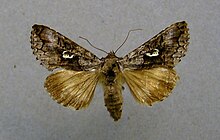Syngrapha interrogationis
| Syngrapha interrogationis | |
|---|---|
 |
|
| Scientific classification | |
| Kingdom: | Animalia |
| Phylum: | Arthropoda |
| Class: | Insecta |
| Order: | Lepidoptera |
| Family: | Noctuidae |
| Genus: | Syngrapha |
| Species: | S. interrogationis |
| Binomial name | |
|
Syngrapha interrogationis (Linnaeus, 1758) |
|
| Synonyms | |
|
|
Syngrapha interrogationis, the scarce silver Y, is a moth of the Noctuidae family. It is found in the northern areas of the world, from Alaska, through Canada, Iceland, Europe, Siberia up to Northeast Asia including Japan.
The wingspan is 32–38 mm. "Forewing bright purplish grey, suffused with black in median area and towards apex; the edges of the stigmata and the lines lustrous grey; inner and outer lines black, double; the inner sinuous above middle, and forming three small curves below it; the outer regularly crenulate throughout; the subterminal line preceded by a conspicuous black dentated and indented line, with a blackish cloud towards apex; a row of pale grey lunules before the terminal marks; the subcellular silvery mark highly variable, either forming a simple loop with fine silvery edge, - ab. orbata ab. nov. [Warren], — or followed by a small silvery dot, as in the type form, or by a large round spot conjoined to it, rarely separate, — ab. flammifera Huene; a development of this last, - ab. ignifera ab. nov. [Warren] — has the usual silvery mark pale yellow, as in some examples of flammifera, shaped like a tadpole, with deep fiery red scaling before the outer line, beyond the inner, and along the submedian fold; hindwing brownish luteous clouded with darker and with a broad blackish border; the type, male from Livonia, is in the Tring Museum; the subsp. transbaikalensis Stgr., from Dauria and East Siberia, is more uniform bluish grey, with very little black suffusion on forewing and paler, hindwings; this form is also recorded from Esthland by Petersen; ab. rosea Tutt, from Scotland, has a rosyground colour in place of bluish grey; ab. cinerea ab. nov. [Warren] has the ground colour dull ashy grey with scarcely any dark markings, except the subterminal line, and no purplish suffusion, the silvery mark a somewhat triangular loop; of this form the Tring Museum possesses three examples from Cedre, Hautes Pyrenees; in the same museum is still another grey form, much resembling cinerea, but with a complete silvery gamma mark and somewhat more developed dark shades; this specimen is from Cauterets in the Pyrenees, and may be distinguished as ab. gammifera ab. nov. [Warren]; these last two grey forms are probably specifically distinct from interrogationis L. "
There are three recognised subspecies:
...
Wikipedia
